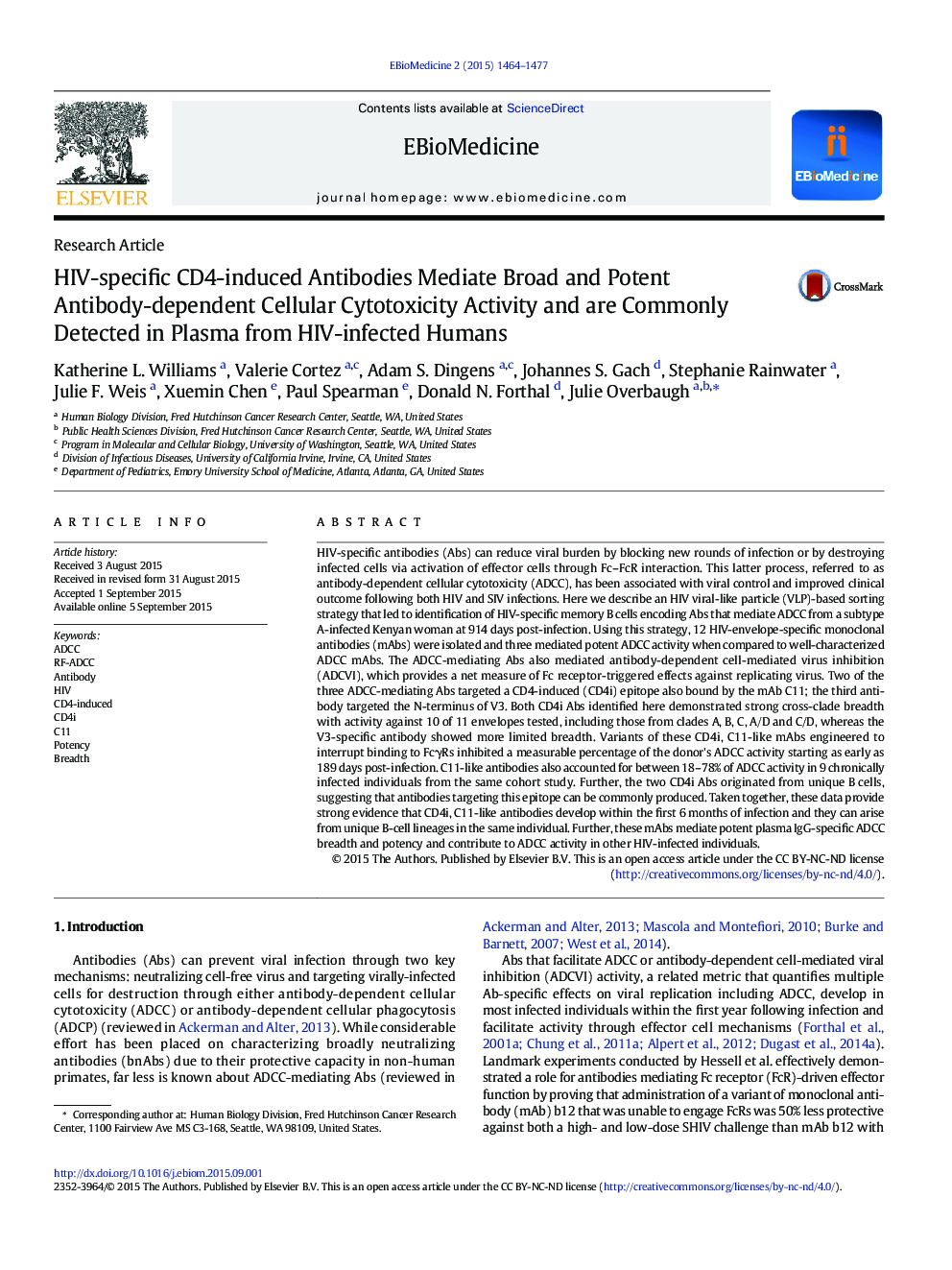| کد مقاله | کد نشریه | سال انتشار | مقاله انگلیسی | نسخه تمام متن |
|---|---|---|---|---|
| 2121235 | 1085772 | 2015 | 14 صفحه PDF | دانلود رایگان |

• We identified new HIV-specific mAbs that mediate broad and potent ADCC & ADCVI activities.
• Two potent mAbs targeted CD4i, C11-like epitopes and originated from unique B cells.
• C11-like Abs were common and constituted 18–78% of plasma ADCC activity.
• C11-like antibodies could be measured in plasma as early as 189 days post-HIV-infection.Following HIV infection, an individual mounts an immune response that includes virus-specific antibodies, some of which destroy HIV-infected cells via antibody-dependent cellular cytotoxicity (ADCC). Studies have identified correlations between ADCC-mediating antibodies and improved clinical outcome in HIV infection. Here, we identified and characterized three monoclonal antibodies that mediated potent ADCC against diverse HIV strains. Two antibodies contributed significantly to the donor's ADCC activity early after infection and similar antibody responses were produced by other HIV-infected individuals from the same cohort. These data suggest that potent ADCC-mediating Abs are commonly made and therefore may be a target benchmark for vaccine strategies.
HIV-specific antibodies (Abs) can reduce viral burden by blocking new rounds of infection or by destroying infected cells via activation of effector cells through Fc–FcR interaction. This latter process, referred to as antibody-dependent cellular cytotoxicity (ADCC), has been associated with viral control and improved clinical outcome following both HIV and SIV infections. Here we describe an HIV viral-like particle (VLP)-based sorting strategy that led to identification of HIV-specific memory B cells encoding Abs that mediate ADCC from a subtype A-infected Kenyan woman at 914 days post-infection. Using this strategy, 12 HIV-envelope-specific monoclonal antibodies (mAbs) were isolated and three mediated potent ADCC activity when compared to well-characterized ADCC mAbs. The ADCC-mediating Abs also mediated antibody-dependent cell-mediated virus inhibition (ADCVI), which provides a net measure of Fc receptor-triggered effects against replicating virus. Two of the three ADCC-mediating Abs targeted a CD4-induced (CD4i) epitope also bound by the mAb C11; the third antibody targeted the N-terminus of V3. Both CD4i Abs identified here demonstrated strong cross-clade breadth with activity against 10 of 11 envelopes tested, including those from clades A, B, C, A/D and C/D, whereas the V3-specific antibody showed more limited breadth. Variants of these CD4i, C11-like mAbs engineered to interrupt binding to FcγRs inhibited a measurable percentage of the donor's ADCC activity starting as early as 189 days post-infection. C11-like antibodies also accounted for between 18–78% of ADCC activity in 9 chronically infected individuals from the same cohort study. Further, the two CD4i Abs originated from unique B cells, suggesting that antibodies targeting this epitope can be commonly produced. Taken together, these data provide strong evidence that CD4i, C11-like antibodies develop within the first 6 months of infection and they can arise from unique B-cell lineages in the same individual. Further, these mAbs mediate potent plasma IgG-specific ADCC breadth and potency and contribute to ADCC activity in other HIV-infected individuals.
Journal: EBioMedicine - Volume 2, Issue 10, October 2015, Pages 1464–1477